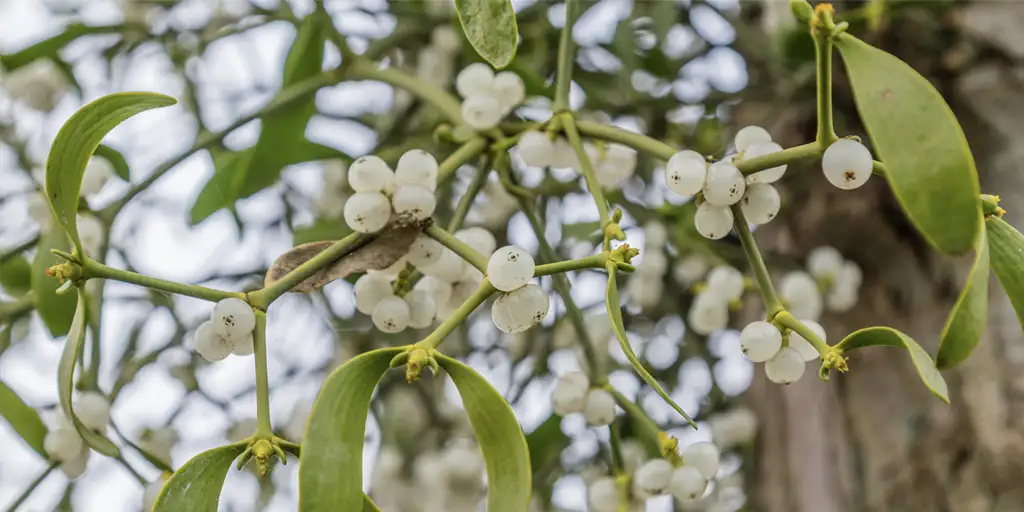Mistletoe and its history as a natural medicine
While it is best known in our culture as a holiday decoration, the mistletoe plant has a long and distinguished history as a natural medicine. Some ancient societies revered mistletoe as having unique powers, and it is mentioned in Norse and Greek mythology as well as in ancient Roman poetry. It has been used to treat various conditions for millennia, including epilepsy, headache, and other disorders involving the nervous system. For about the past century, European mistletoe, also known as Viscum album, has been used as an injectable treatment for cancer patients, helping to improve their quality of life and support their anticancer immunity.
Early use of mistletoe therapy for cancer patients
The Dutch physician Ita Wegman, who along with the Austrian philosopher and social reformer Rudolph Steiner co-founded a holistic healing approach known as anthroposophic medicine, pioneered the use of mistletoe extracts in the early twentieth century. She and her research partners observed encouraging results including improved quality of life, better ability to function, and decreased cancer-related symptoms in many patients. Also, patients receiving radiation therapy appeared to suffer less fatigue and other treatment-related side effects while receiving mistletoe. She noted that patients who benefitted from mistletoe injections tended to develop a local reaction with some redness and increased warmth around the injection site. While Dr. Wegman had only very rudimentary laboratory testing available to her, she theorized that the local redness and warmth was due to an effect on the immune system. This belief may have been influenced by the work of her contemporary researcher William Coley, whose work with “Coley’s Toxin” and the induction of fevers hinted at the potential for immune-directed therapies to have effects on cancer. Later research subsequently confirmed Dr. Wegman’s theory about mistletoe’s effects on the immune system.
Medicinal properties of mistletoe
The mistletoe plant grows on the branches of certain trees and shrubs and blooms in the wintertime, when most other vegetation has gone dormant for the season. Therapeutic extracts are produced from a combination of its characteristic white berries along with its leaves and stems. While the plant contains several substances with known biologic activity, its beneficial effects appear to be mainly due to two types of compounds, known as lectins and viscotoxins. Mistletoe lectins are proteins which have the ability to attach to and exert effects on certain cells including immune cells and cancer cells. Viscotoxins are compounds that help protect the plants against bacteria, parasites, and fungi, and there is evidence that viscotoxins can cause damage to cancer cells in humans. Together, the lectins and viscotoxins appear to exert both destructive effects on cancer cells as well as helpful effects on the immune system. In modern cancer care, mistletoe is often given by subcutaneous injection, although it can also be given intravenously. Taken orally, mistletoe is considered a homeopathic remedy for certain conditions including headache. There is no evidence that oral mistletoe is helpful for patients with cancer.
Mistletoe clinical studies reveal promising results
While there have been many clinical studies of mistletoe over the past few decades, the studies have been small and of variable scientific quality. Some of these small studies have shown very promising results; however, lack of funding has hampered efforts to move forward with larger trials. Interestingly, a high quality early phase (“Phase 1”) clinical trial evaluating intravenous mistletoe therapy was recently completed at the highly respected Johns Hopkins University in Baltimore and these results have been published in the journal Cancer Research Communications1. This study enrolled 21 patients with various types of cancer whose disease had progressed on standard treatments. Mistletoe was initially given at a low dose and doses were increased as tolerated. Five of the 21 patients experienced stability of their cancer without progression, and three of these five actually showed some degree of tumor shrinkage, although no patients had enough tumor shrinkage to meet the criteria for “response”. Tumor marker blood tests showed a trend toward stabilizing at the higher treatment dose levels. Mistletoe treatment was found to be very well-tolerated overall, although some study participants reported fatigue, nausea, and chills. Despite these reported side effects, overall quality of life in the participants showed a trend toward improvement over the course of the treatment. Based on the encouraging results of this study, the researchers are planning to move forward with larger trials of intravenous mistletoe, possibly in combination with standard cancer treatments. Other small studies have indicated that mistletoe appears to be safe to combine with chemotherapy, that it may improve quality of life for chemotherapy patients2, 3, and that it has the potential to improve cancer outcomes for these patients as well4. At least one small study appears to indicate that mistletoe can be safely given together with standard immunotherapy treatments (“checkpoint inhibitors”) without worsening the immune-related side effects of these drugs5.
Is Mistletoe therapy an effective cancer treatment?
Given the lack of larger confirmatory trials of mistletoe therapy up to this point, it has not received US Food and Drug Administration approval and it is not yet considered a standard cancer treatment in this country. However, many patients in the US are currently receiving mistletoe therapy under the care of integrative physicians. Mistletoe is also used fairly commonly in some parts of Europe. Interest in mistletoe therapy appears to be growing both in this country and worldwide, and recent research findings are likely to build this momentum even further. While mistletoe is not a cure for cancer, evidence is accumulating that it can be a useful part of a cancer treatment regimen. Its gentleness, safety, and apparent benefits both in terms of quality of life as well as cancer treatment outcomes make it an attractive natural therapy with the potential to help a great many patients.
Pages Others Viewed After This One
Adaptogens in Cancer Care
Fasting in Integrative Oncology
About Us
New Patients



